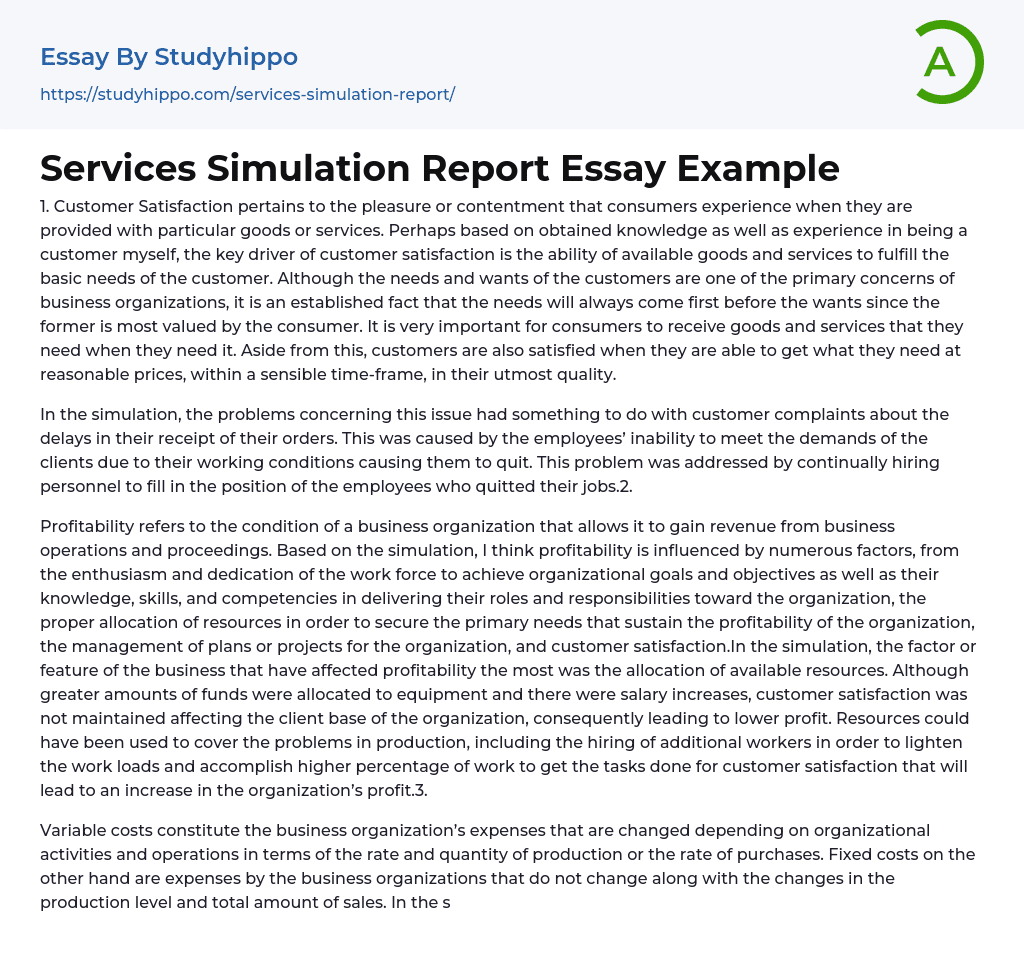Customer Satisfaction is the contentment felt by consumers upon receiving particular goods or services that meet their basic needs. Meeting customer needs takes priority over wants and is key to driving satisfaction. Timeliness, affordability, and quality are essential factors in delivering the required goods and services for customers to be satisfied.
The issue addressed in the simulation involved delays in order delivery due to customer complaints about employees being unable to meet client demands and quitting due to poor working conditions. To alleviate this problem, the organization continuously hired personnel to replace those who left.
Profitability, which pertains to a business organization's capacity to obtain revenue from its operations and proceedings, can be influenced by various factors such as the workforce's dedication, expertise, and proficiency in accomplishing their roles and objectives, the proper allocation of r
...esources to sustain profitability, effective management of plans or projects, and customer satisfaction. Based on the simulation, the allocation of available resources showed the greatest impact on profitability as it affected customer satisfaction and resulted in a decrease in profit despite increased funding for equipment and higher salaries. To address this issue, resources could have been utilized to hire additional workers and improve production to achieve customer satisfaction and increase profits for the organization.
The expenses of a business organization that vary according to the rate and quantity of production or the rate of purchases are known as variable costs. On the other hand, fixed costs are expenses that remain constant even when the organization's production level or total sales change. In the simulation, variable costs include the resources allocated to equipment and the rent paid for storing inventory. In February, due t
increased production of parts, extra space was required for storage, which led to the need for additional rental space.
This paragraph discusses various costs associated with running a business. The cost of renting space and equipment varies according to the production rate and is thus considered a variable cost. In May, the funds allocated to equipment expenses were reduced to accommodate other business needs. Fixed costs, such as employee salaries, remain constant regardless of sales or production rates. While salaries were increased to increase productivity, they do not directly impact production or sales.
It is crucial for an organization to employ competent personnel who can fulfill specific roles and duties as employee performance is closely linked to organizational operations and production. The author rightly emphasizes the importance of this, as a missing workforce would render the organization unable to continue operating. Therefore, it is imperative that organizations recruit knowledgeable and efficient personnel who meet or exceed job requirements.
For an organization to achieve its goals and objectives, it is crucial that specific tasks and responsibilities are fulfilled. Failure to do so can result in decline. To avoid this, organizations should take into account not only the cognitive abilities and skills of potential employees but also their work behavior and attitude during the hiring process. In a simulation, some employees frequently called in sick or quit early, which may be partly due to the organization's actions or lack thereof; however, their work behavior also impacted their performance. This emphasizes the significance of considering candidates' cognitive abilities, skills, and work behavior when assigning them tasks and responsibilities.
One decision that led to success was reallocating resources to promote employees. This
helped employees feel secure in their position and provided them opportunities for career growth and development. In turn, new employees were hired to fill vacant positions resulting from resignations and the organization's promotional program.
As a result of improved productivity and employee engagement, the organization successfully achieved its goals and objectives. Resources were allocated more efficiently, eliminating unnecessary overspending on equipment. However, despite the intention to increase productivity and motivation through salary increases, employee retention and attendance did not improve. In fact, many employees still resigned and frequently called in sick.
Establishing collaborative relationships with employees through open communication could have addressed the issue. Salary increase did not help but rather led to overspending. Achieving the simulation goals - customer satisfaction and maximized profitability - would have been possible with more time for organizational development. The organization was in poor shape from the start, and restoring conditions for growth and development through customer satisfaction and profitability will take more than a year to complete.
In the initial year, the organization focused on identifying its shortcomings and identifying the necessary improvements. The organization may require an additional six months to one year to correct the issues discovered in the previous year, including salary adjustments, effective employee communication, optimal resource allocation, and new employee recruitment, through the implementation of new programs, projects, and policies.
- Customer essays
- Customer Satisfaction essays
- Customer Service essays
- Target Market essays
- American Dream essays
- Barriers To Entry essays
- Capitalism essays
- Central Bank essays
- Compensation essays
- Consumerism essays
- Economic Development essays
- Economic Growth essays
- Economic Inequality essays
- Economic System essays
- Economy essays
- Employment essays
- Export essays
- Finance essays
- Free Trade essays
- Gross Domestic Product essays
- Human Development essays
- Income Inequality essays
- Industry essays
- Inflation essays
- International Business essays
- International Trade essays
- Macroeconomics essays
- Materialism essays
- Max Weber essays
- Microeconomics essays
- Minimum Wage essays
- Monetary Policy essays
- Monopoly essays
- Pricing essays
- Profit essays
- Recession essays
- resources essays
- Taxation essays
- Trade essays
- Unemployment essays
- Warehouse essays
- World economy essays
- Career Choice essays
- Career Goals essays
- Career Plan essays
- Community Service essays
- Dream Job essays
- Duty essays
- Employee essays
- Internship essays




